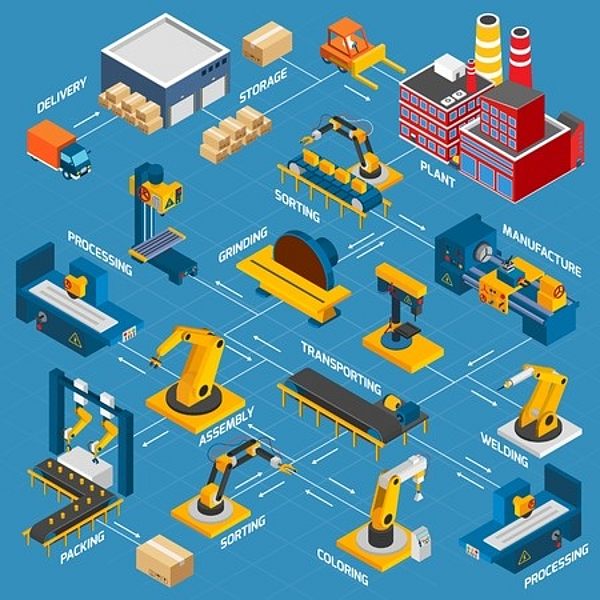Production Management
Production Management

Learning outcomes
After the successful completion of this course, the students will have learnt
- to describe production systems as well as the objectives and tasks of production planning and control,
- to model and evaluate production processes,
- to explain the economic foundation and conceptual elements of hierarchical production planning,
- to apply basic methods of procurement and production planning as well as manufacturing control,
- to depict the architecture of information systems for integrated production planning and control, and
- to state the principles of Lean Production and Smart Manufacturing and to follow them for the design of real production systems.
Contents
Chapter 1: Production systems and production planning
1.1 Production processes and production systems
1.2 Target system of production management
1.3 Performance analysis of production systems
1.4 Planning, control, and organization of production systems
Chapter 2: Foundations of production planning
2.1 Production economics
2.2 Hierarchical planning
2.3 Coping with uncertainty
Chapter 3: Design of framework conditions
3.1 Strategic potentials
3.2 Strategic planning
3.3 Configuration planning
Chapter 4: Aggregate production planning
4.1 Master production scheduling
4.2 Aggregate personnel capacity planning
4.3 Aggregate project scheduling
Chapter 5: Materials requirements planning
5.1 Classification of materials
5.2 Materials requirements forecast
5.3 Materials requirements calculation
Chapter 6: Lot-sizing
6.1 Inventory management
6.2 Deterministic static models
6.3 Deterministic dynamic models
6.4 Stochastic models
Chapter 7: Production scheduling
7.1 Rough-cut capacity planning
7.2 Detailed scheduling
7.3 Mixed-model line balancing and sequencing
7.4 Manufacturing control methods
Chapter 8: Business application systems for production planning and control
8.1 PPC and ERP systems
8.2 Advanced Planning systems
8.3 Manufacturing Execution systems
Chapter 9: Lean Production and Smart Manufacturing
9.1 Value stream orientation
9.2 Quality assurance and maintenance
9.3 Staff and supplier development
9.4 Kaizen and continuous improvement
9.5 Smart Manufacturing
Literature
- Bloech J, Bogaschewsky R, Buscher U, Daub A, Götze U, Roland F (2014) Einführung in die Produktion. Springer, Berlin
- Corsten H, Gössinger R (2016) Produktionswirtschaft. Oldenbourg, München
- Curry GL, Feldman RM (2011) Manufacturing Systems Modeling and Analysis. Springer, Berlin
- Erlach K (2020) Wertstromdesign: Der Weg zur schlanken Fabrik. Springer-VDI, Berlin
- Günther H-O, Tempelmeier H (2016) Produktion und Logistik. Books on Demand, Norderstedt
- Nahmias S, Olsen TL (2015): Production and Operations Analysis. Waveland Press, Long Grove
- Neumann K (1996) Produktions- und Operations-Management. Springer, Berlin
- Schneeweiß C (2002) Einführung in die Produktionswirtschaft. Springer, Berlin
- Schneider HM, Buzacott JA, Rücker T (2005) Operative Produktionsplanung und -steuerung. Oldenbourg, München
- Steven M (2018) Industrie 4.0: Grundlagen, Teilbereiche, Perspektiven. Kohlhammer, Stuttgart
- Tempelmeier H (2008) Material-Logistik. Springer, Berlin
- Thonemann U (2015) Operations Management. Pearson Education, München
GAMS Models
The following table compiles models and sample data for different planning problems and solution methods that are dealt with during the course. The model and example files contain source code written in the algebraic modeling language GAMS, which can be executed using the GAMS system. The GAMS system includes a greater number of state-of-the-art solvers for several types of mathematical programs, providing optimal or locally optimal solutions.
By modifying the example files, new instances can easily be generated for scenario analyses or when preparing the final course exam. A free demo version of the current GAMS system can be downloaded and installed from the web pages of GAMS Development Corp. You need a demo license for the installation, which can be requested using the form provided on the download web page. By return you will receive an email with the license, which must be added to the system during the installation process following the description in the email. The GAMS models can be edited and solved using a simple text editor called GAMS IDE or the with development environment GAMS Studio. In both environments, the comprehensive documentation of the entire GAMS system is available under the "Help" tab.
![[Translate to English:] [Translate to English:]](/fileadmin/_processed_/2/5/csm_DJI_0107-HDR_bear_5e97ef9396.jpg)